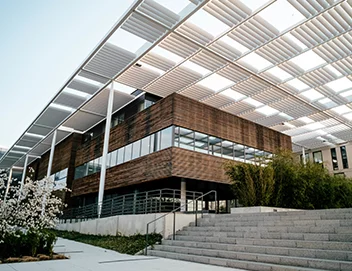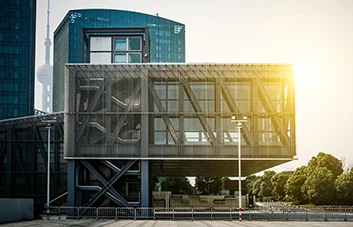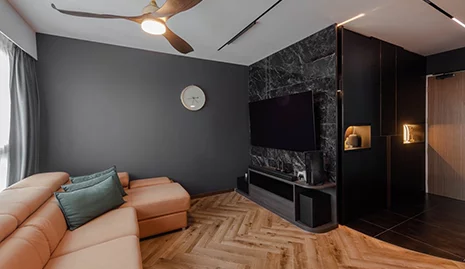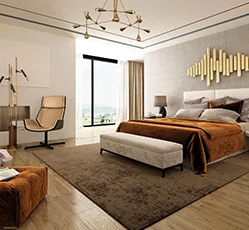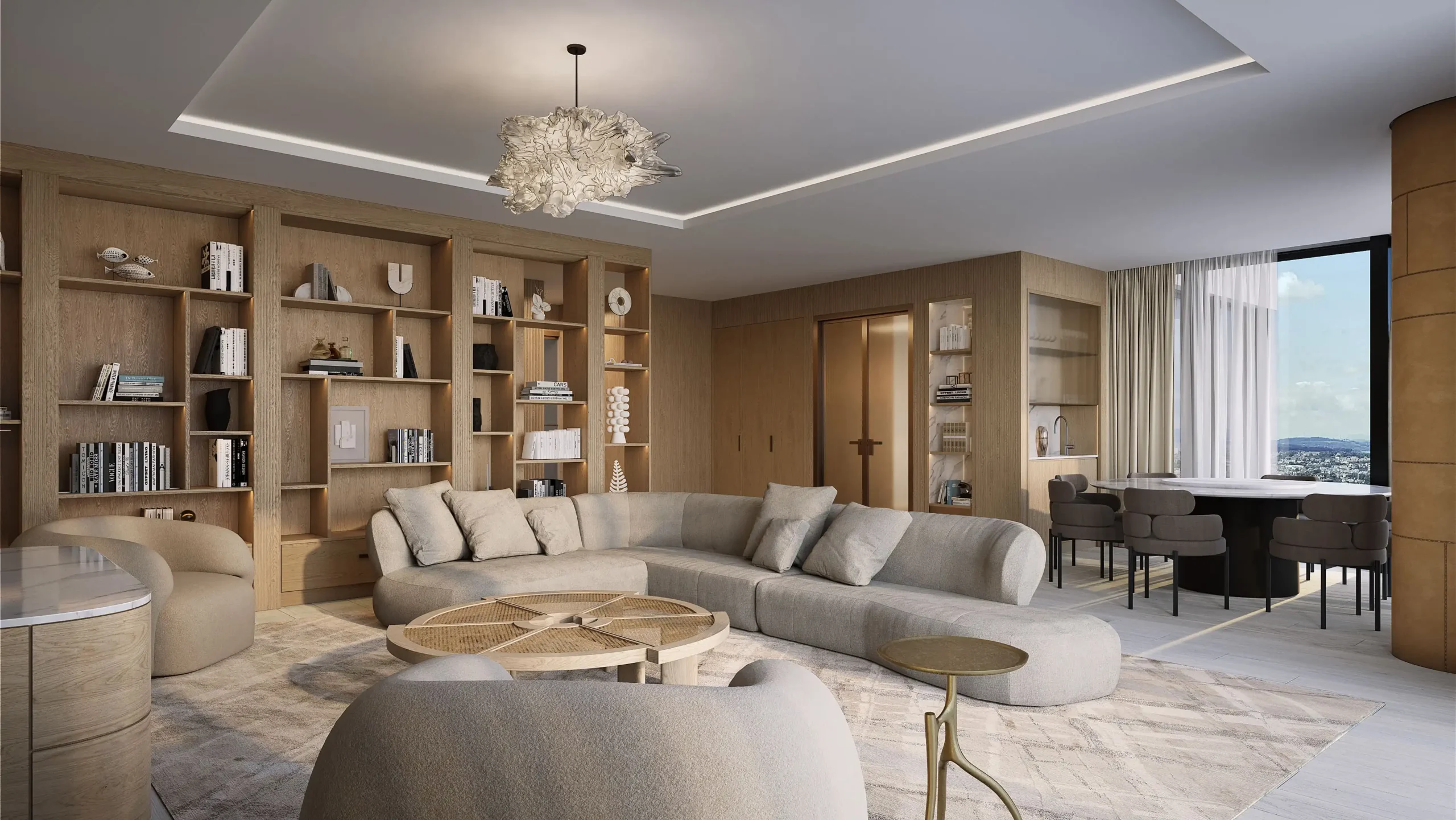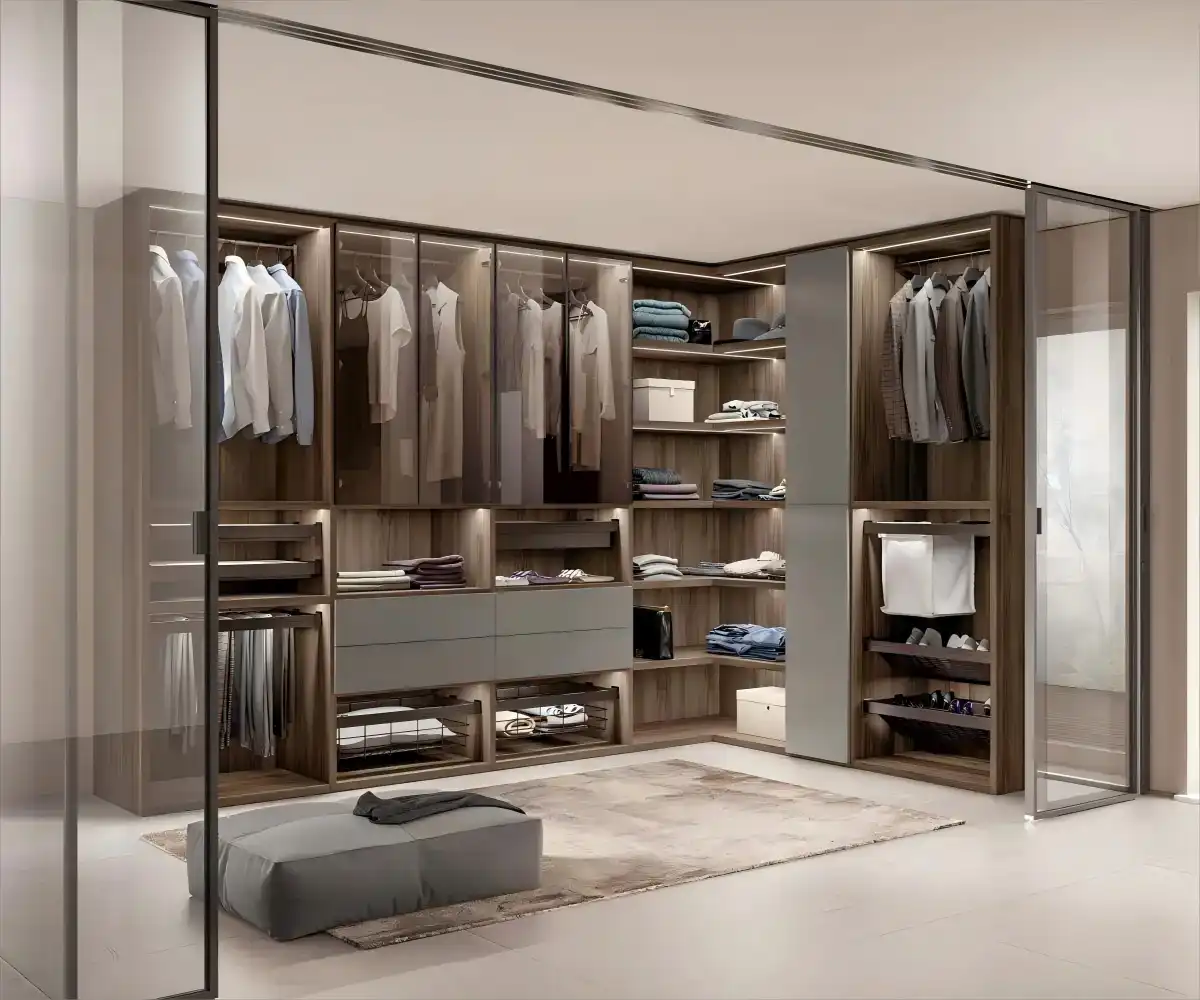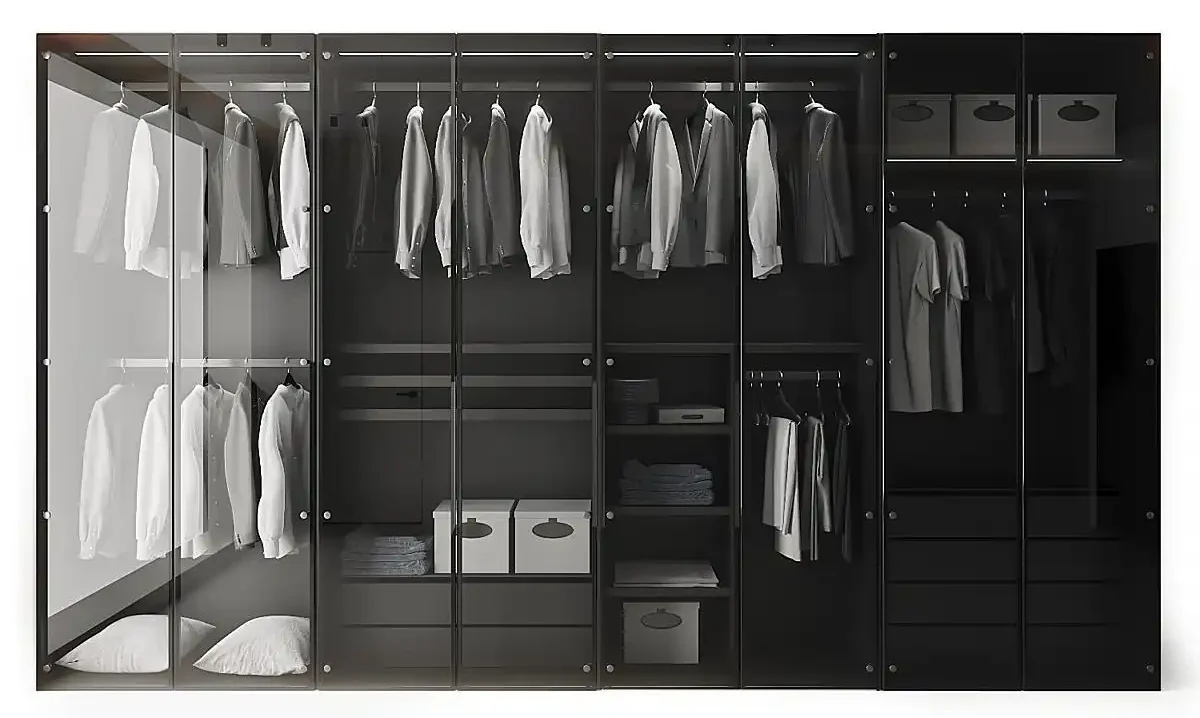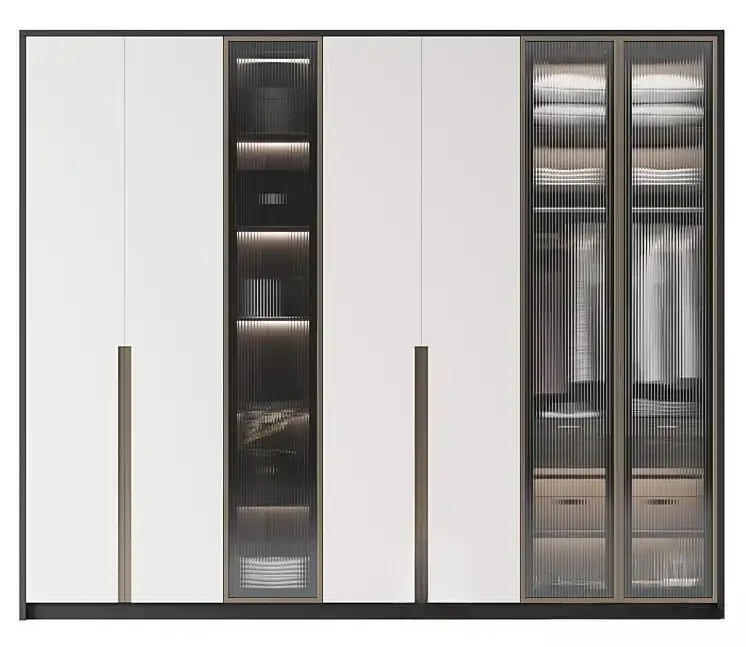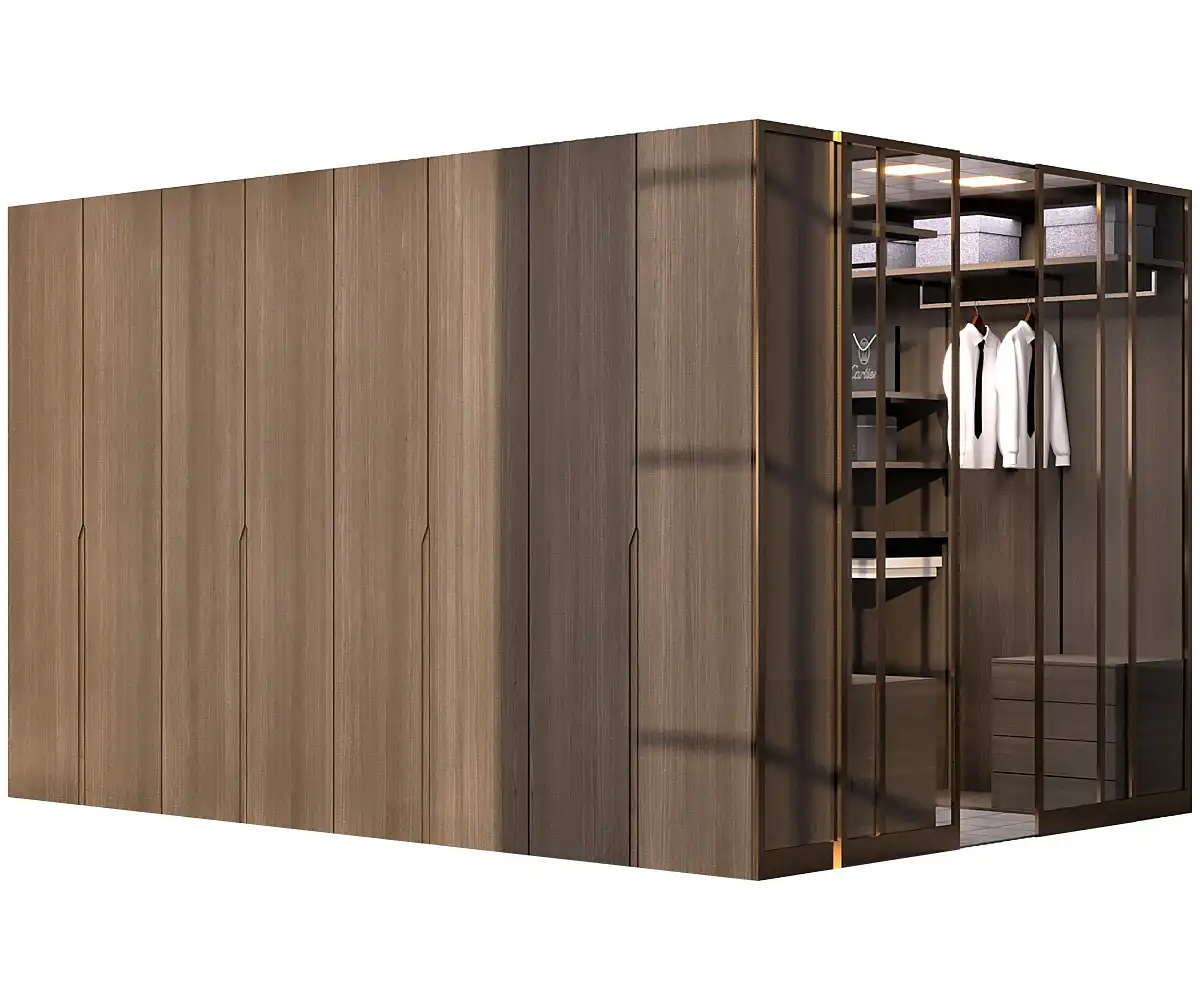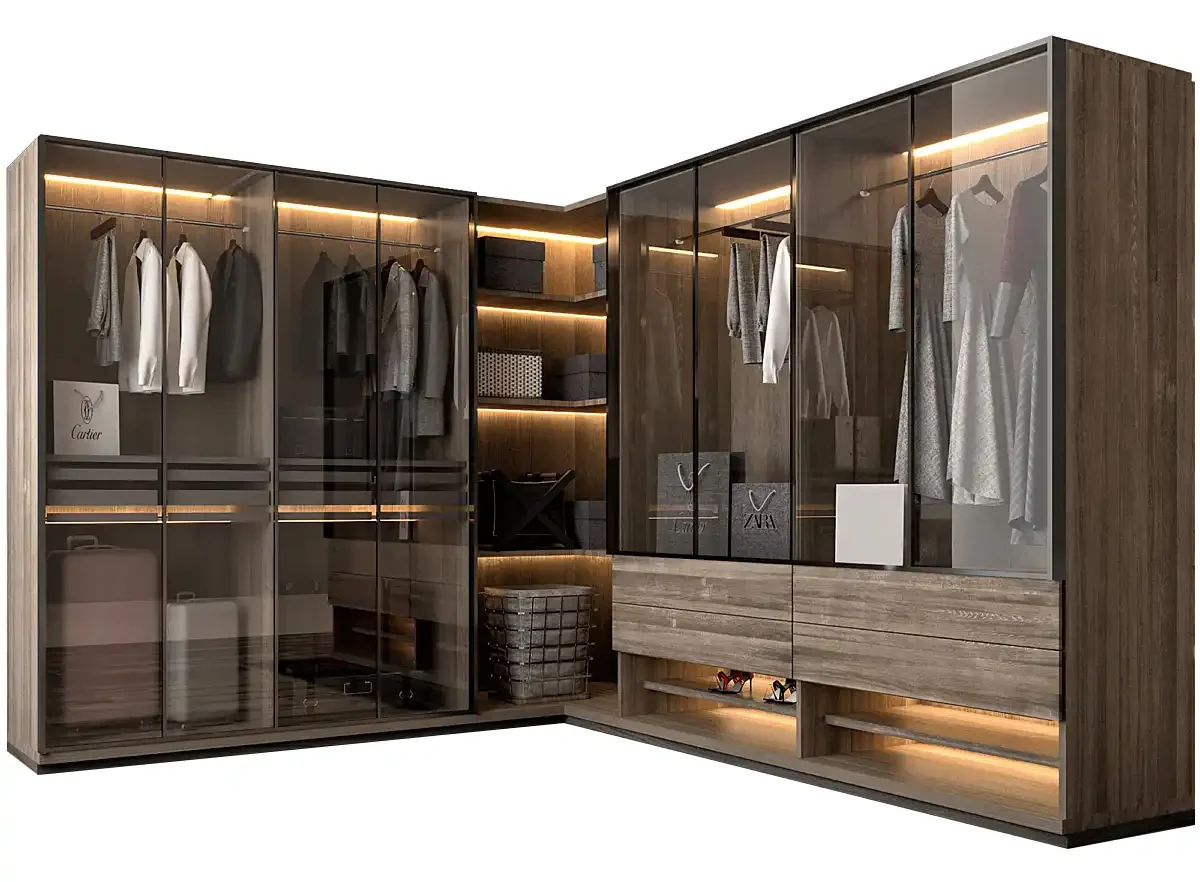Introduction to Wardrobes
The wardrobe is an indispensable furniture piece balancing functionality and aesthetics. A well-designed wardrobe organizes clothing efficiently while enhancing room harmony—whether through minimalist lines, rustic wood finishes, or sleek metal frames. This guide covers wardrobe types, material selection, cost breakdowns, and 2025 design trends, equipping readers to create storage solutions aligned with space constraints, budget, and style preferences. From tiny apartments to luxury villas, these insights transform storage from a necessity into a design statement.
Related Articles:
Is PVC Wall Panel a Good Choice for Modern Homes?
Why Are Wooden Interior Doors So Popular?
What are the Different Types of Wardrobes?
Walk-in Wardrobes
Ideal for spacious bedrooms (>12㎡), walk-in wardrobes function as mini dressing rooms with dedicated zones for hanging clothes, folded items, and accessories. Features include full-length mirrors, built-in LED lighting (2700K warm white for morning routines), and adjustable shelves (30-60cm depth options). A standard 15㎡ walk-in wardrobe includes dual hanging rods (160cm for dresses, 110cm for shirts), pull-out shoe racks (30+ pairs capacity), and a central island with jewelry tray.
Best for: Large clothing collections (100+ garments), luxury home designs, and individuals who view getting dressed as a daily ritual.
Built-in Wardrobes
Custom-designed to fit wall recesses or entire wall spans, built-in wardrobes eliminate wasted space between the unit and walls/ceiling. They excel in small rooms (<8㎡) or spaces with architectural quirks like sloped ceilings, chimney breasts, or uneven walls.
Case Study: Sloped Ceiling Transformation
A 6㎡ London attic bedroom with a 45° sloped ceiling (minimum height 60cm, maximum 220cm) was transformed with a built-in wardrobe featuring variable-height shelves (30-120cm adjustability), deep drawers (50cm depth) for off-season storage, and mirror-fronted sliding doors (visually expanding room size by 30%).
Result: 30% more storage capacity than a freestanding unit, while maintaining 80% floor space for daily activities.
Freestanding Wardrobes
Portable standalone units that require no permanent installation, ideal for renters or those who frequently rearrange their space. Available in widths from 80cm to 200cm, balancing storage capacity with flexibility. Popular models include IKEA HEMNES (180cm×195cm, pine, $499) with 3 drawers + 2 shelves, and West Elm Mid-Century Walnut (180cm×200cm, $899) featuring solid wood frame and dovetail drawers.
Installation Tip: Secure units over 1.8m tall to walls with anti-tip brackets to prevent tipping accidents.
Choosing Tip: Use the “3S Rule”—Space (measure room dimensions first), Storage needs (count garments by type), and Style (match decor theme).
What is the Best Wardrobe Material?
Твердая древесина
Core Varieties:
- Oak: $80-120/㎡, 12% moisture resistance, ideal for high-traffic bedrooms
- Walnut: $150-200/㎡, rich chocolate hue that darkens with age, suitable for luxury interiors
- Pine: $40-60/㎡, softwood with visible knots, perfect for rustic decor
Environmental Credentials: Look for FSC certification (Forest Stewardship Council), ensuring wood from sustainably managed forests. Each ㎡ of FSC-certified oak reduces carbon footprint by 3.6kg compared to non-certified alternatives.
Pros: Durable (20-50 year lifespan), refinishable (can be sanded/repainted 3-5 times), natural insulation properties.
Cons: High cost (3-5x MDF), sensitive to humidity changes (expansion rate 2% in damp conditions).
Applicable Scene: Long-term investment, vintage/Nordic styles.
MDF (Medium-Density Fiberboard)
Safety Grades:
- E0-grade: ≤0.5mg/L formaldehyde emission (safe for bedrooms,达到婴儿房安全标准)
- E1-grade: ≤1.5mg/L formaldehyde emission (suitable for living areas)
Pros: Budget-friendly (1/3 the cost of solid wood), dimensionally stable (expansion rate <0.5%), easy to paint/veneer.
Cons: Moisture-sensitive (swells 15-20% when exposed to water), limited lifespan (5-10 years with heavy use).
Applicable Scene: DIY projects, temporary housing, budget-conscious装修.
Стекло
Types & Applications:
- Clear Tempered Glass (5mm thickness): Best for walk-in wardrobes with organized interiors
- Frosted Glass: Privacy with 70% light transmission, ideal for bedroom built-ins
- Textured Glass: Adds visual interest and hides dust, popular in contemporary designs
Pros: Visually expands small spaces by 20-30%, sleek modern aesthetic, easy to clean.
Cons: Shows fingerprints (requires weekly cleaning), fragile (professional installation recommended).
Applicable Scene: Small rooms, contemporary decor, accent pieces.
Sustainable Materials (Bamboo/Reclaimed Wood)
Bamboo: Rapidly renewable (3-5 years to maturity), natural antimicrobial properties, $40-70/㎡. Reclaimed Wood: Unique character from previous use, $60-100/㎡, saves 70% production energy vs. new wood.
Pros: Eco-friendly, unique aesthetic, carbon-neutral production.
Cons: Limited availability, higher cost than MDF.
Applicable Scene: Environmentally conscious buyers, rustic/bohemian styles.
Comparison Table
| Material | Cost/㎡ | Lifespan | Key Advantage | Applicable Scene: |
| Твердая древесина | $40-200 | 20-50yrs | Durability | Long-term use, retro style |
| MDF | $20-40 | 5-10yrs | Affordability | DIY projects, temporary housing |
| Стекло | $50-80 | 15-20yrs | Space expansion | Small-sized, modern style |
| Bamboo | $40-70 | 10-15yrs | Sustainability | Environmental protection needs, natural style |
How Much Does a Wardrobe Cost?
Price Ranges
**Budget ($200-500)**: Basic freestanding MDF units with fixed shelves and standard hinges. Example: IKEA BRIMNES Wardrobe ($249, 150cm width) includes 1 hanging rod, 1 shelf, and 2 drawers—suitable for 50-70 garments.
**Mid-Range ($500-2,000)**: Solid wood veneer or high-quality MDF with soft-close hardware, adjustable shelves, and partial customization. Example: Wayfair Artisan Solid Wood Veneer Wardrobe ($899, 180cm width) features 5 drawers, LED lighting, and mirror inserts—stores 100-120 garments.
**Luxury ($2,000+)**: Custom designs with premium materials (solid wood, metal frames), smart technology integration, and bespoke organization systems. Example: Poliform Wink Wardrobe ($15,000+, custom width) with FSC-certified walnut and motion-sensor lighting.
Cost Drivers Breakdown
Proportion of material costs: 60% of total expense, with solid wood components costing 3-5x more than MDF. Hardware upgrades (soft-close hinges vs. standard) add $144 to a 6-door wardrobe. Size impacts cost at 15-20% per 30cm width increase, while floor-to-ceiling designs cost 30% more than standard height but add 40% storage.
10-Year Cost Comparison
Finished Wardrobe: $1,500 total (initial $500 + 2 replacements every 5 years), 60% space efficiency
Custom Wardrobe: $2,000 total (initial $2,000 + 0 replacements), 95% space efficiency
Key Insight: Custom offers 58% more storage per dollar despite higher upfront cost.
Money-Saving Strategies with Examples
- Material Mixing: Use walnut veneer doors ($300) with MDF Cabinet ($500) instead of all-solid walnut ($1,600)—saves $800.
- Seasonal Purchasing: Buy during Black Friday (15-30% off mid-range models) or 618 Festival (import tax savings on European brands).
- Function Prioritization: Skip decorative top cabinets and glass doors—focus on hanging rods and drawers for 25% cost reduction.
Which Wardrobe Style is Trending in 2025?
Minimalist Design
Characterized by clean lines, handleless doors, and monochromatic color palettes (oatmeal, charcoal gray, soft sage). Key features include:
- Handleless Technology Options:
- Press-type Rebounder: Built-in spring mechanism pops door open 1.5cm with gentle pressure
- Invisible pull handle: Recessed groove along door edge, maintaining flush surface
- Magnetic contact closure: Silent closing without visible hardware
Example: Lema “Frame” wardrobe with invisible hinges and flush edges creates a seamless wall-like appearance, making 12㎡ bedrooms feel larger.
Smart Technology Integration
2025 smart wardrobes combine functionality with connectivity:
- Climate Control: Built-in dehumidifiers maintain 45-55% humidity (ideal for fabric preservation), triggering alerts when levels exceed 60%.
- Motion-Sensor Lighting: LED strips activate when doors open, providing 2700K warm light for morning routines.
- App Connectivity: Basic inventory management and shelf adjustment via smartphone, with premium models offering outfit recommendations based on weather.
Adoption Rate: 35% of new luxury homes will include smart wardrobe systems by 2025 (Statista, 2024), up from 12% in 2020.
Eco-Friendly Materials
Sustainable innovations dominate 2025 trends:
- Recycled Wood: Reclaimed oak and pine from old barns, featuring unique grain patterns and imperfections.
- Low-VOC Finishes: Water-based paints and sealants with Greenguard certification (formaldehyde <0.1mg/m³).
- Bamboo: Heat-treated at 180℃ (carbonization treatment) to reduce moisture absorption to ≤12%, achieving ASTM D3273.
Example: IKEA’s 2025 SINDVIK wardrobe uses 95% recycled materials and is Cradle-to-Cradle Gold certified, with full recycling at end-of-life.
Why Invest In a Custom Wardrobe?
Space Maximization Case Study
Challenge: 7㎡ bedroom with sloped ceiling (minimum height 60cm, maximum 220cm) in Hong Kong apartment.
Custom Solution: 1.2m width wardrobe with:
- Adjustable shelves (30cm-120cm height) following ceiling slope
- Pull-down hanging rod (lowers 80cm for easy access to high shelves)
- Narrow-depth drawers (35cm) for folded items in tight spaces
Results: Stores 80 garments (standard freestanding unit holds 50), while maintaining 70cm clear walkway.
Custom vs. Freestanding Space Utilization
| Target | Custom Wardrobe | Finished Wardrobe |
| Utility Rate of Space | 100% | 60-70% |
| Irregular Space Adaptation | perfect fit | There is a gap. |
| Personalized Storage Solutions | support | fixed configuration |
Common Customization Mistakes to Avoid
- Over-Specifying Fixed Features: Client requested fixed shoe shelves for 10 pairs, limiting future storage flexibility. Solution: Use adjustable dividers.
- Underestimating Budget: Hidden costs (wall preparation, special hardware) added 25% to final bill. Solution: Add 10-15% contingency.
- Ignoring Future Needs: Family with young children designed adult-height shelves, requiring step stool use for 5 years. Solution: Include lower adjustable sections (50-150cm range).
Conclusion: Action Plan for Your Wardrobe Project
- Precision Measurement: Use apps like MagicPlan to create 3D room model, noting dimensions, architectural features, and delivery access.
- Needs Assessment: Count garments by type, list must-have features (mirror, shoe storage), and gather style inspiration.
- Budget Allocation: 60% for materials, 25% for labor, 15% contingency.
- Vendor Selection: Review portfolios, verify certifications (FSC, E0), and check customer references.
- Final Inspection: Test door alignment, drawer operation, and lighting; verify warranty coverage.
Final Tip: Design for adaptability—adjustable shelves and neutral colors ensure your wardrobe evolves with changing needs and trends.

